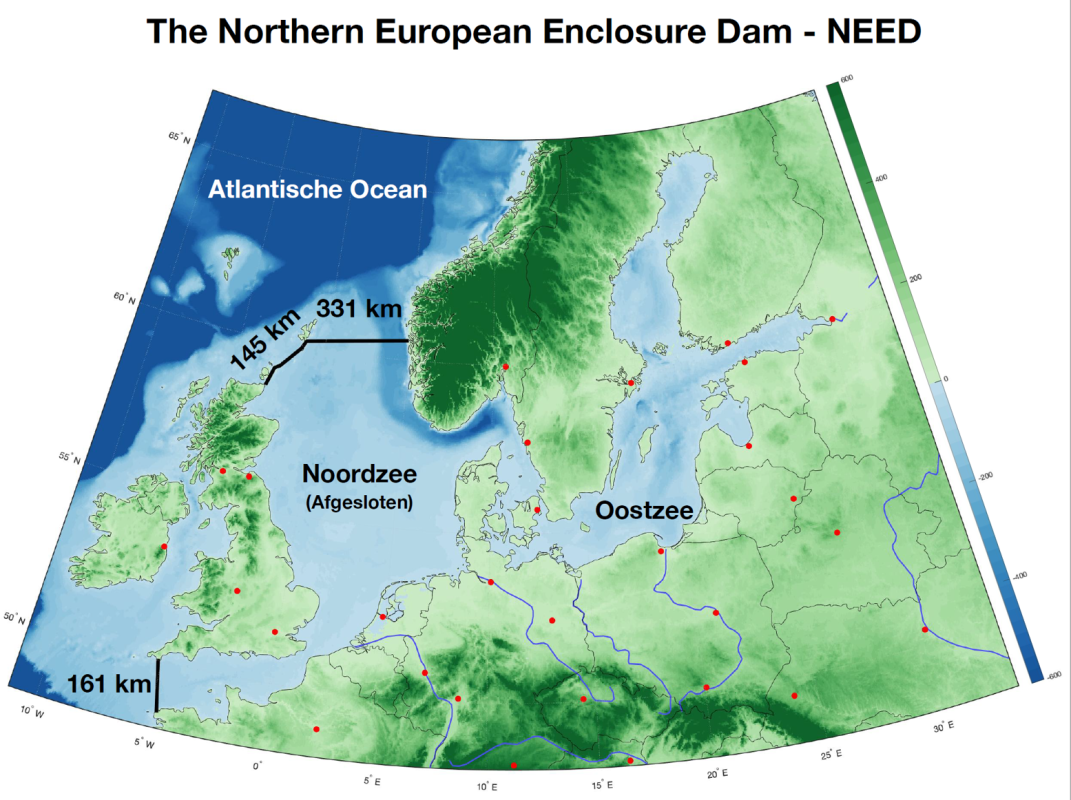
The sea-level is rising, year after year; up to an expected rise of up to 10 metres in the coming centuries. So how to protect the people living in the low countries against the consequences? Of course, every single government could decide to build its own dams, dykes and walls, but what if you could build a single big one that could protect everybody at once? Yes, why not build sturdy, 475 kilometres long dam between Norway and Scotland? Or wait, why not build a second one as well, 160 kilometres between Cornwall and Bretagne? With these structures, one could protect half of Europe against the rising water. With some extra measures around Ireland maybe even more.
Megalomaniac idea? Not at all, it’s a feasible project, according to Sjoerd Groeskamp, an oceanographer at the Dutch Koninklijk Nederlands Instituut voor Onderzoek der Zee, and his German colleague Joakim Kjellson of GEOMAR. They are about to publish their findings in the scientific journal of the American Meteorological Society.
UPDATE February 13: here’s Kjellson and Groeskamp’s paper
The two dams would protect more than 25 million Europeans from the consequences of an expected sea-level rise of a few metres in the coming centuries. The cost, 250 to 500 billion euros, is ‘only’ 0.1% of the Gross Domestic Product of all countries protected by such a dam, Groeskamp says. “Apart from being a possible solution, our design of such an extreme dam is mainly a warning”, says Groeskamp in an article published on the NIOZ website. “It reveals the immensity of the problem hanging over our heads.”
Noordzeedam is technically feasible
“The construction of such a ‘North-European Enclosure Dam‘ seems to be technically feasible”, Groeskamp emphasises. “The maximum depth of the North Sea between France and England is scarcely one hundred metres. The average depth between Scotland and Norway is 127 metres, with a maximum of 321 metres just off the coast of Norway. We are currently able to build fixed platforms in depths exceeding 500 metres, so such a dam seems feasible too.”
Economy and nature
The authors acknowledge that the consequences of this dam for North Sea wildlife would be considerable. “The tide would disappear in a large part of the North Sea, and with it the transport of silt and nutrients. The sea would eventually even become a freshwater lake. That will drastically change the ecosystem and therefore have an impact on the fishing industry as well”, Groeskamp says.
“We estimated the financial costs for the construction of the dam by extrapolating the costs for large dams in South Korea, for example.” But there are more costs to consider. In the final calculation, Groeskamp and Kjellson want to also take into account factors such as the loss of income from North Sea fishing, the increased costs for shipping across the North Sea and the costs of gigantic pumps to transport all of the river water that currently flows into the North Sea to the other side of the dam.
“The description of this extreme dam is more of a warning than a solution. However, we have calculated that the cost of doing nothing against sea level rise will ultimately be many times higher.”
“Ultimately, the description of this extreme dam is more of a warning than a solution”, Groeskamp states. ‘The costs and the consequences of such a dam are huge indeed. However, we have calculated that the cost of doing nothing against sea level rise will ultimately be many times higher. This dam makes it almost tangible what the consequences of the sea level rise will be; a sea-level rise of 10 metres by the year 2500 according to the bleakest scenarios.”
Therefore, Groeskamp says, “this dam is mainly a call to do something about climate change now. If we do nothing, then this extreme dam might just be the only solution.”
Source: Koninklijk Nederlands Instituut voor Onderzoek der Zee
More articles on the consequences of climate change can be found via this link.








